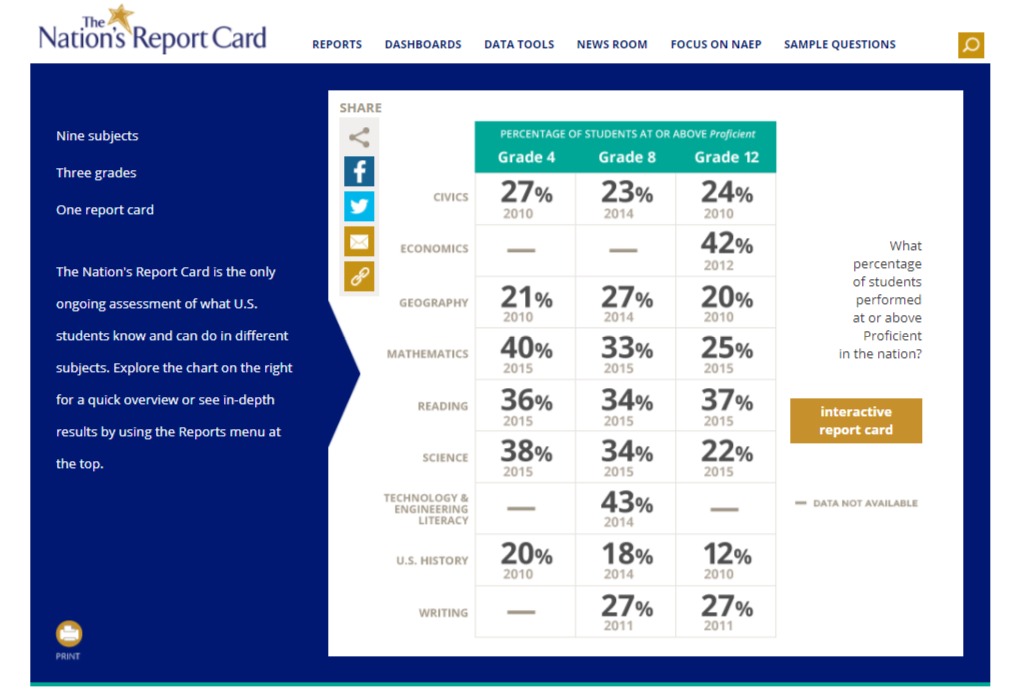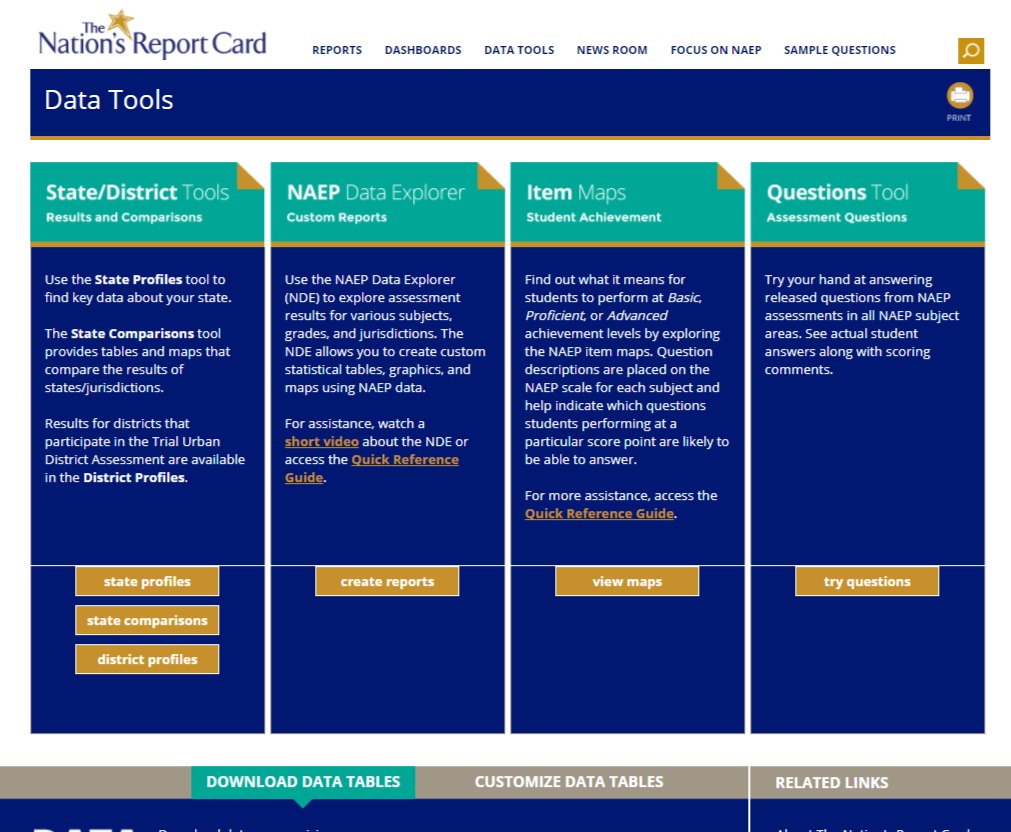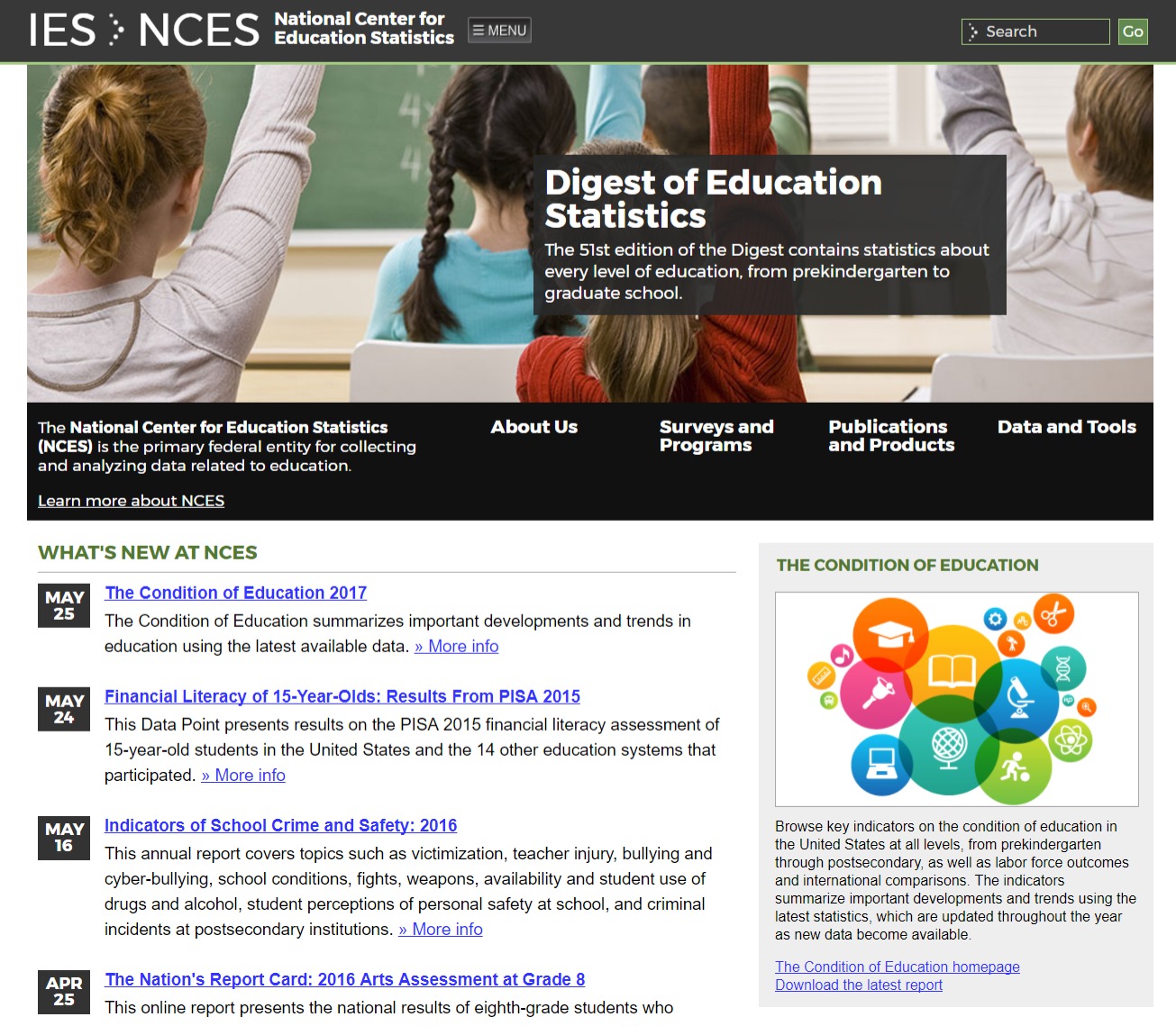
About NAEP
Overview
The National Assessment of Educational Progress (NAEP) is the largest nationally representative, continuing evaluation of the condition of education in the United States. It has served as a national yardstick of student achievement since 1969. Through The Nation’s Report Card, NAEP informs the public about what American students know and can do in various subject areas and compares achievement among states, large urban districts, and various student groups.
NAEP 101
View a video introduction to The Nation’s Report Card.
NAEP is a congressionally mandated program administered by the National Center for Education Statistics within the U.S. Department of Education. The National Assessment Governing Board oversees and sets policy for NAEP.
What NAEP Covers
NAEP assessments are conducted periodically in mathematics, reading, civics, science, technology and engineering literacy, U.S. history, and writing, and formerly the arts, economics, geography. The main NAEP assessments are conducted at grades 4, 8, and 12; however, each subject’s assessment does not necessarily involve all three grades.
The NAEP long-term trend assessment, administered since the early 1970s, assesses students at ages 9, 13, and 17 in reading and mathematics.
See the NAEP Assessment Schedule for a list of recent and upcoming NAEP assessments.
The NAEP Trial Urban District Assessment (TUDA) was initiated in 2002 to measure the achievement of fourth- and eighth-grade students in large urban school districts, with 27 voluntarily participating as of 2017.
The National Assessment Governing Board is responsible for determining the content and design of each NAEP assessment. For each subject, the Governing Board adopts a framework to describe the content and format of the tests at grades 4, 8, and 12. The frameworks are not intended to represent a specific curriculum or instructional approach, but to provide a general outline of what NAEP should test. The frameworks are developed through a comprehensive process that involves the active participation of diverse groups such as teachers, curriculum specialists, local school administrators, parents, and members of the general public.
The Governing Board adopts achievement levels that represent what students should know and be able to do in each subject and grade that NAEP tests. The achievement levels capture informed judgments of “how good is good enough” and help explain assessment results beyond scale scores. For each achievement level — NAEP Basic, NAEP Proficient, and NAEP Advanced — there is a written description of what that level of performance means for a given subject and grade, a set of sample questions that exemplifies performance at that level, and a minimum score on the NAEP scale.
The general policy definitions for achievement levels currently in use were adopted by the Governing Board in 1993.
- NAEP Basic – Denotes partial mastery of prerequisite knowledge and skills that are fundamental for proficient work at each grade.
- NAEP Proficient – Represents solid academic performance. Students reaching this level have demonstrated competency over challenging subject matter, including having knowledge of the subject matter, being able to apply such knowledge to real-world situations, and possessing analytical skills related to the subject matter.
- NAEP Advanced – Signifies performance beyond Proficient.
To set the levels for each subject, preliminary descriptions are adopted after wide public consultation. Broadly representative panels — composed of classroom teachers, other educators, and knowledgeable members of the public — are then convened to make final recommendations to the Governing Board. The panels examine the questions and student performance data in a tightly structured process conducted by a contractor with extensive experience in the field of standard setting.
As provided by law, the achievement levels are to be used on a trial basis until the Commissioner for Education Statistics determines, as a result of an evaluation, that such levels are reasonable, valid, and informative to the public.
NAEP Design
See the National Center for Education Statistics’ technical documentation on how students are selected to participate in NAEP assessments.
The main NAEP assessments are given in winter, from late January through early March. The results of the mandatory reading and mathematics assessments for grades 4 and 8 are typically reported six months after the tests are administered. The other NAEP results are usually reported one year following the assessment’s administration.
The long-term trend assessments are administered at three different times of the year: in the fall for 13-year-olds, winter for 9-year-olds, and spring for 17-year-olds. Results are usually reported one year following the assessment’s administration.
See the NAEP Assessment Schedule and Release Schedule for a list of recent and upcoming NAEP assessments.
Federal and State Context
NAEP assessments began in 1969. Under the No Child Left Behind Act of 2001 and then the Every Student Succeeds Act of 2015, Congress requires all states to participate in the NAEP reading and mathematics assessments at the fourth and eighth grades every two years as a condition for receiving federal aid. No sanctions or rewards are tied to NAEP results. State participation in NAEP assessments for all other subjects and grades is completely voluntary.
Since NAEP is designed to produce group scores, and is prohibited by Congress from reporting individual student results, it tests only a relatively small number of students in each state. Also, each student in the NAEP sample takes just part of the full assessment. By law, NAEP is forbidden to report individual school results, to influence curriculum, and to be used for high-stakes purposes.
The Governing Board believes strongly that NAEP plays an important role in providing a reliable measure of student achievement over time that is independent of changes in state standards. While the NAEP frameworks and Common Core State Standards represent overlapping content regarding what students know and should be able to do, there are distinct differences in the design and appropriate uses of NAEP as compared with state assessments.
NAEP survey questionnaire responses are kept confidential, ensuring the privacy of students, teachers, and administrators. In addition, all student responses are combined, so no data on any individual student can ever be identified. All participants in the NAEP assessment are also assigned a unique identification number to ensure that they cannot be linked to any personally identifiable information, such as a name or address. For further protection, information collected from both the assessment and the survey questionnaire is always handled according to federal standards and industry best practices.
To ensure that NAEP is fully representative of the nation, students selected to participate must include English language learners and students with disabilities. The National Assessment Governing Board’s inclusion and accommodation policy guidelines are intended to maximize student participation in NAEP, minimize the potential for bias, promote fair comparisons, and maintain trends in reporting student achievement.
Read the Governing Board’s policy statement and see the National Center for Education Statistics’ policy on the inclusion of these student groups in NAEP.


